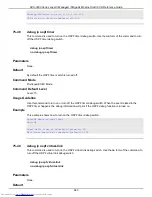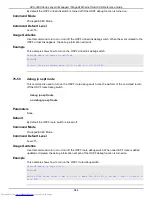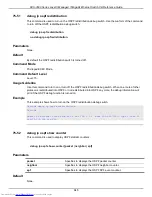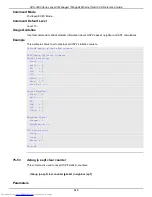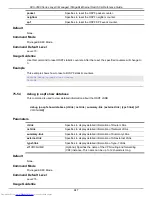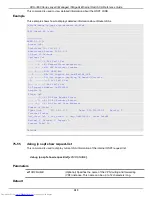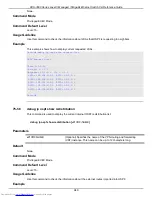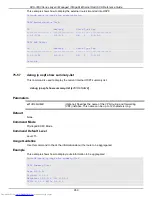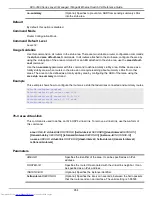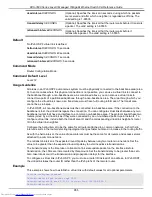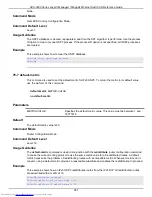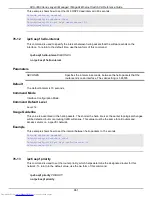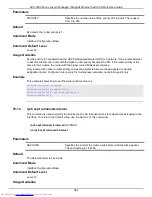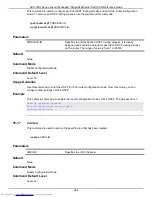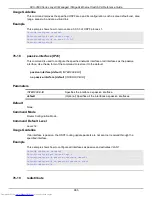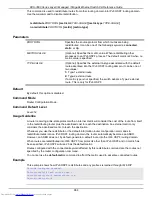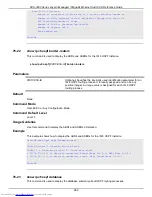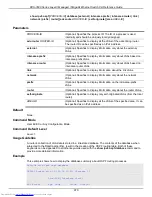
DXS-3600 Series Layer 3 Managed 10Gigabit Ethernet Switch CLI Reference Guide
955
dead-interval SECONDS
(Optional) Specifies the interval in seconds, during which no packets
are received and after which a neighbor is regarded as off-line. The
valid setting is 1-65535.
transmit-delay SECONDS
(Optional) Specifies the interval that the router waits before it transmits
a packet. The valid setting is 1-65535.
retransmit-interval SECONDS
(Optional) Specifies the interval that the router waits before it
retransmits a packet. The valid setting is 1-65535.
Default
No IPv6 OSPF virtual link is defined.
hello-interval SECONDS
: 10 seconds.
dead-interval SECONDS
: 40 seconds.
transmit-delay SECONDS
: 1 seconds.
retransmit-interval SECONDS
: 5 seconds.
Command Mode
Router Configuration Mode.
Command Default Level
Level: 12.
Usage Guideline
All areas in an IPv6 OSPF autonomous system must be physically connected to the backbone area (area
0). In some cases where this physical connection is not possible, you can use a virtual link to connect to
the backbone through a non-backbone area. As mentioned above, you can also use virtual links to
connect two parts of a partitioned backbone through a non-backbone area. The area through which you
configure the virtual link, known as a transit area, must have full routing information. The transit area
cannot be a stub area.
In IPv6 OSPF, all non-backbone areas must be connected to a backbone area. If the connection to the
backbone is lost, the virtual link repairs the connection. You can configure virtual links between any two
backbone routers that have an interface to a common non-backbone area. The protocol treats these two
routers joined by a virtual link as if they were connected by an un-numbered point-to-point network. To
configure virtual link, include both the transit area ID and the corresponding virtual link neighbor's router
ID in the virtual link neighbor.
Configure the hello-interval to be the same for all routers attached to a common network. A short hello
interval results in the router detecting topological changes faster but also an increase in the routing traffic.
As with the hello interval, the value of dead-interval must be the same for all routers and access servers
attached to a common network.
The retransmit-interval is the expected round-trip delay between any two routers in a network. Set the
value to be greater than the expected round-trip delay to avoid needless retransmissions.
The transmit-delay is the time taken to transmit a link state update packet on the interface. Before
transmission, the LSUs are incremented by this amount. Set the transmit-delay to be greater than zero.
Also, take into account the transmission and propagation delays for the interface.
To configure a virtual link in IPv6 OSPF, you must use a router ID instead of an address. In IPv6 OSPF,
the virtual link takes the router ID rather than the IPv6 prefix of the remote router.
Example
This example shows how to establish a virtual link with default values for all optional parameters.
Switch# configure terminal
Switch(config)# ipv6 router ospf 1000
Switch(config-rtr)# area 0.0.0.1 virtual-link 192.168.255.1
Switch(config-rtr)#
Summary of Contents for DXS-3600 Series
Page 1: ......
Page 423: ...DXS 3600 Series Layer 3 Managed 10Gigabit Ethernet Switch CLI Reference Guide 418 ...
Page 548: ...DXS 3600 Series Layer 3 Managed 10Gigabit Ethernet Switch CLI Reference Guide 543 ...
Page 673: ...DXS 3600 Series Layer 3 Managed 10Gigabit Ethernet Switch CLI Reference Guide 668 ...
Page 712: ...DXS 3600 Series Layer 3 Managed 10Gigabit Ethernet Switch CLI Reference Guide 707 Switch ...
Page 845: ...DXS 3600 Series Layer 3 Managed 10Gigabit Ethernet Switch CLI Reference Guide 840 ...
Page 884: ...DXS 3600 Series Layer 3 Managed 10Gigabit Ethernet Switch CLI Reference Guide 879 ...
Page 1152: ...DXS 3600 Series Layer 3 Managed 10Gigabit Ethernet Switch CLI Reference Guide 1147 ...



